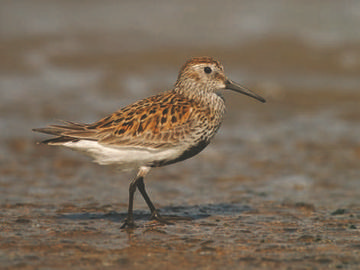
Dunlin © Steve Round
The Dunlin has been on its way out as a breeder in the county for many years, and our First Atlas remarked that it had only the slenderest of toe-holds here. The last on record was the year after fieldwork finished for our First Atlas, in 1985, when the stark ‘one or two pairs bred in the Cheshire hills’ in the annual Cheshire Bird Report does not, with hindsight, do justice to the occasion.
The decline in breeding Dunlins is not restricted to Cheshire. Between the first two BTO national Atlases (1968-72 and 1988-91), they were lost as a breeding bird from many of their southernmost 10-km squares, in the Pennines, Wales, the Scottish borders and Ireland. The BTO Second Atlas has birds ‘seen’, the equivalent of possible breeding, in three 10-km squares in Cheshire (SJ58, SJ68 and SJ69) but the instructions for that Atlas made no requirement for birds to be in suitable breeding habitat, and it is certain that birds in those 10-km squares had no intention to breed there.
Many possible reasons have been put forward for the decline in breeding birds of the uplands across Britain, including habitat deterioration and loss, perhaps through overgrazing, or drainage; increased predation following reductions in gamekeeping; disturbance by ramblers; and increased afforestation. Climate change is implicated for many other northern species, and presumably Dunlin as well. It is not clear to what extent, if at all, these varied factors have operated in the Cheshire part of the Peak District, but Dunlins would struggle to find much of their preferred wet moorland habitat, especially with areas of cotton-grass Eriophorum latifolium that they favour.
A survey of the South Pennines Moors SPA, of which the Cheshire moors are a part, showed a 32% drop between 1990 and 2004-05 in the breeding population of Dunlins and none was found south of Kinder Scout in SK08 (Eaton et al 2007).
There is still a substantial spring passage of Dunlins through the estuaries, with odd birds at other sites, but none in suitable breeding habitat although they sometimes sing on spring migration. Dunlin was recorded as possibly breeding in two of the Dee saltmarsh tetrads during our First Atlas, and the species probably bred in this habitat during 1997-2000 on the Ribble and Morecambe Bay (Pyefinch & Golborn 2001).
The birds in England and Wales are the most southerly breeding Dunlin in the world, and the species is predicted to be lost completely as an English breeder later this century, as climate change takes effect (Huntley et al 2007).
Sponsored by www.deeestuary.co.uk

